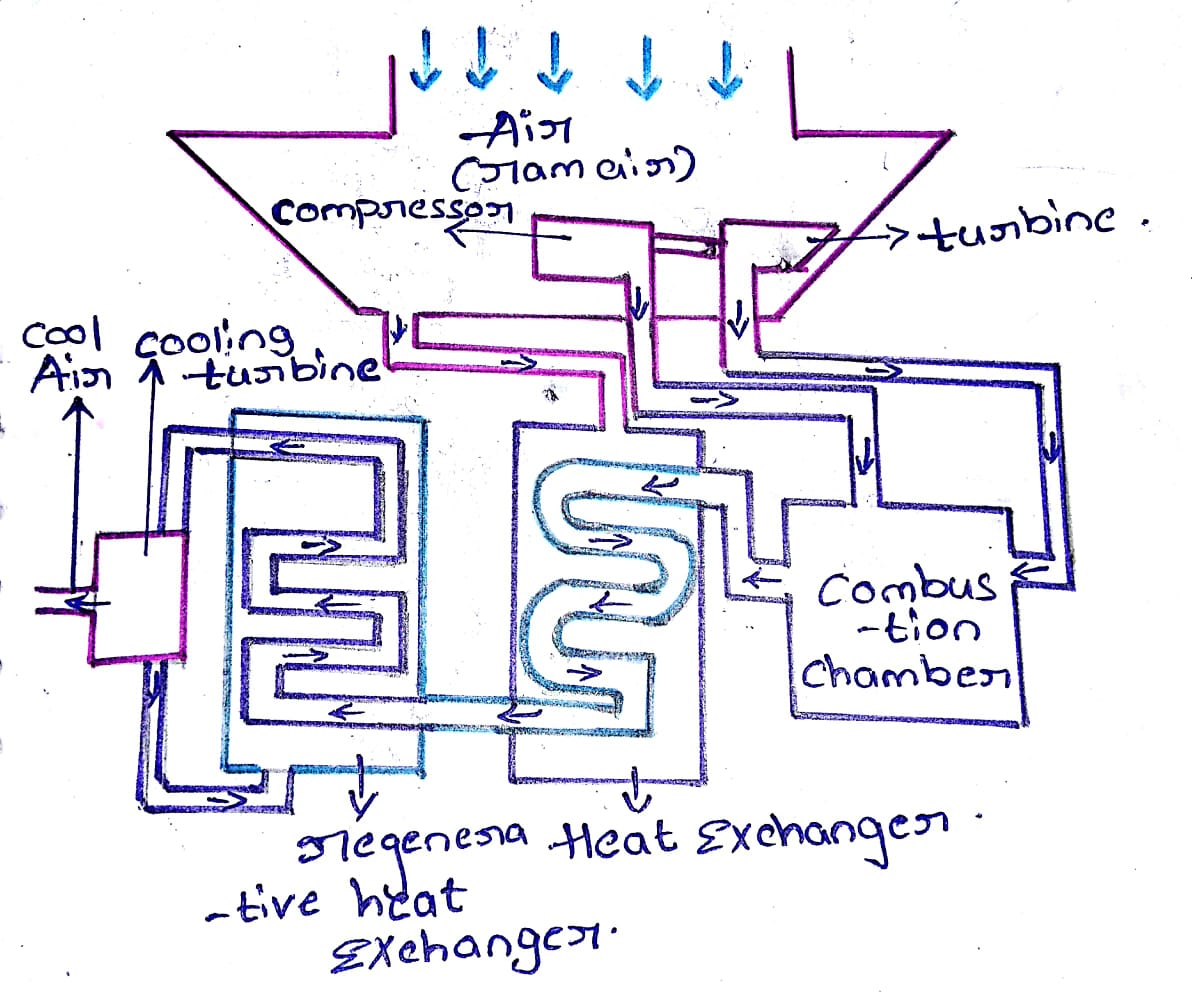What is Capillary Tube?
A capillary tube is a narrow, thin-walled tube used in refrigeration and air conditioning systems as a metering device to control the flow of refrigerant from the high-pressure side (condenser) to the low-pressure side (evaporator). It is a simple and cost-effective component that serves as an alternative to more sophisticated expansion devices like thermal expansion valves (TXVs).
Key features and characteristics of capillary tubes:
- Design: Capillary tubes are typically made of copper or aluminum due to their good thermal conductivity. They are characterized by their small diameter, ranging from 0.5 to 2.0 millimeters.
- Function: The primary function of a capillary tube is to create a pressure drop in the refrigerant, causing it to expand and cool as it enters the evaporator coil. This cooling effect is essential for the absorption of heat from the surroundings.
- Metering Device: Capillary tubes act as a metering device by restricting the flow of refrigerant. The pressure drop across the capillary tube causes the refrigerant to undergo a phase change from liquid to vapor, absorbing heat in the process.
- Location: Capillary tubes are typically installed between the condenser and the evaporator in the refrigeration or air conditioning system. They are often coiled to fit into limited space and may have insulation to prevent heat gain.
- No Moving Parts: Unlike some other expansion devices, capillary tubes have no moving parts, making them simple and reliable. However, this simplicity also means they offer less precise control over the refrigerant flow compared to more advanced devices.
- Application: Capillary tubes are commonly found in domestic refrigerators, small air conditioning units, and other compact refrigeration systems where cost-effectiveness and simplicity are essential.
Working principle:
As high-pressure liquid refrigerant enters the capillary tube, the restriction causes a significant pressure drop. This drop in pressure leads to a corresponding drop in temperature, causing the refrigerant to undergo a phase change into a mixture of liquid and vapor. This mixture then enters the evaporator coil, where the remaining liquid evaporates, absorbing heat from the surroundings and facilitating the cooling process.
While capillary tubes are straightforward and reliable, they may have limitations in terms of efficiency and control, especially in systems with varying load conditions. In such cases, more sophisticated expansion devices like thermal expansion valves (TXVs) may be preferred for better control over the refrigerant flow.
What is Capillary Tube Used For?
A capillary tube is used as a metering device in refrigeration and air conditioning systems to control the flow of refrigerant from the high-pressure side (condenser) to the low-pressure side (evaporator). Its primary purpose is to create a pressure drop in the refrigerant, causing it to undergo a phase change and absorb heat as it enters the evaporator coil. Here are some key applications and uses of capillary tubes:
- Domestic Refrigerators:
- Capillary tubes are commonly used in domestic refrigerators as a cost-effective and simple metering device. They help regulate the flow of refrigerant to achieve efficient cooling in the refrigerator’s evaporator coil.
- Small Air Conditioning Units:
- Capillary tubes are often found in small air conditioning units, particularly those designed for compact spaces or individual rooms. Their simplicity and reliability make them suitable for such applications.
- Commercial Refrigeration Systems:
- While larger commercial refrigeration systems may use more sophisticated expansion devices, capillary tubes can still be employed in certain configurations or applications within the system.
- Automotive Air Conditioning:
- Some automotive air conditioning systems use capillary tubes as metering devices. They are suitable for applications where simplicity and cost-effectiveness are crucial.
- Laboratory Refrigeration:
- Capillary tubes may be utilized in small laboratory refrigeration units where precise control over refrigerant flow is not a critical requirement, and cost considerations play a significant role.
- Display Cases and Freezers:
- Capillary tubes can be found in display cases and freezers, especially in systems where their simplicity aligns with the specific cooling needs of the application.
- Refrigeration Units in Remote Locations:
- In certain situations where access to more complex expansion devices is limited, capillary tubes may be used in refrigeration units in remote locations, provided the system requirements align with the capabilities of the capillary tube.
It’s important to note that while capillary tubes are reliable and cost-effective, they have some limitations in terms of precise control over refrigerant flow and may be less suitable for systems with varying load conditions or those requiring more sophisticated temperature and pressure regulation. In such cases, other expansion devices like thermal expansion valves (TXVs) might be preferred.
Capillary Tube in Laboratory?
In laboratory applications, capillary tubes may be used in various equipment for specific purposes related to fluid handling, sample analysis, or temperature control. Here are a few examples of how capillary tubes are utilized in laboratory settings:
- Chromatography:
- Capillary tubes are commonly used in chromatography techniques, such as gas chromatography (GC) or capillary electrophoresis. In GC, the capillary column serves as the separation medium for analyzing the components of a gas sample based on their affinity for the stationary phase.
- Blood Microsampling:
- Capillary tubes are employed for microsampling in blood analysis. A capillary tube is filled by capillary action by touching it to a blood droplet. This method is often used for small-volume blood tests, particularly in pediatric or neonatal care.
- Fluid Transfer and Dispensing:
- Capillary tubes may be used for precise fluid transfer and dispensing in laboratory experiments. Their small diameter allows for controlled sample volumes, making them suitable for applications requiring accuracy in fluid handling.
- Temperature Sensing and Measurement:
- In some instances, capillary tubes are integrated into temperature measurement devices. These devices utilize the thermal expansion of a liquid (such as mercury) within the capillary tube to indicate temperature changes.
- Electrochemistry:
- In electrochemical experiments, capillary tubes may be used to connect reference electrodes to the electrolyte solution. The capillary design helps minimize the disturbance of the solution and maintains a stable electrical connection.
- Sample Collection and Transport:
- Capillary tubes are used for collecting small volumes of liquid samples in laboratory settings. They can be used to transfer these samples to other containers for further analysis or experimentation.
- Micropipettes and Microfluidics:
- Capillary tubes are often integral components of micropipettes used for precise liquid handling in small volumes. Microfluidic devices, which manipulate and analyze fluids on a small scale, also leverage capillary action in their designs.
- Viscometry:
- In viscosity measurements, particularly in the study of fluid flow properties, capillary tubes may be used in viscometers. The rate of flow of a fluid through the capillary tube is measured and used to determine viscosity.
- Temperature Control in Laboratory Equipment:
- Capillary tubes can be part of temperature control systems in laboratory equipment, helping regulate the flow of refrigerants or other temperature-controlling fluids.
- Optical Fiber Fabrication:
- In laboratories involved in optical fiber fabrication, capillary tubes are used to encase the fiber during the drawing process. This helps protect the delicate fiber structure during production.
These applications highlight the versatility of capillary tubes in laboratories, where their small size and ability to handle precise fluid volumes are advantageous for various experimental and analytical procedures.
What is the Principle of Capillary Tube?
The principle of a capillary tube is based on the capillary action, which is the ability of a liquid to flow in narrow spaces against the force of gravity. Capillary action is driven by the combination of cohesive forces (molecular attraction between the liquid molecules) and adhesive forces (molecular attraction between the liquid and the tube material). The primary principles of a capillary tube can be explained as follows:
- Capillary Action:
- The capillary tube takes advantage of capillary action, where a liquid is drawn into a narrow tube or capillary against the force of gravity. This action occurs because the adhesive forces between the liquid and the tube material are stronger than the cohesive forces within the liquid.
- Pressure Difference:
- The capillary tube is positioned in a way that creates a pressure difference between its two ends. Typically, one end is connected to the high-pressure side (condenser) of a refrigeration system, and the other end is connected to the low-pressure side (evaporator).
- Phase Change:
- As the high-pressure liquid refrigerant enters the capillary tube, it undergoes a phase change from liquid to vapor. This phase change is a result of the pressure drop along the length of the capillary tube.
- Temperature Drop:
- The pressure drop in the capillary tube causes a corresponding drop in temperature. The refrigerant absorbs heat from its surroundings, leading to the cooling of the refrigerant.
- Evaporator Entry:
- The refrigerant, now in a mixture of liquid and vapor state, enters the evaporator coil. In the evaporator, the remaining liquid evaporates, absorbing additional heat and facilitating the cooling process.
The capillary tube’s size and length are crucial in determining the pressure drop and temperature change. The capillary tube serves as a metering device, controlling the flow of refrigerant into the evaporator to maintain the desired temperature and pressure conditions. While capillary tubes are simple and reliable, they may not offer the same precision in control as more sophisticated expansion devices like thermal expansion valves (TXVs). The choice between capillary tubes and other devices depends on the specific requirements of the refrigeration or air conditioning system.
How Does a Capillary Tube Work?
A capillary tube works based on the principles of capillary action, pressure differences, and phase changes of a fluid. It is commonly used as a metering device in refrigeration and air conditioning systems to control the flow of refrigerant from the high-pressure side (condenser) to the low-pressure side (evaporator). Here’s a step-by-step explanation of how a capillary tube works:
- Placement in the Refrigeration System:
- The capillary tube is typically installed between the condenser (high-pressure side) and the evaporator (low-pressure side) of a refrigeration or air conditioning system. Its small diameter and length contribute to its ability to regulate the flow of refrigerant.
- High-Pressure Liquid Entry:
- The capillary tube starts at the outlet of the condenser where the refrigerant exists in a high-pressure liquid state. The high-pressure liquid is forced into the capillary tube due to the pressure difference created by the system.
- Capillary Action:
- As the liquid refrigerant enters the narrow capillary tube, capillary action comes into play. Capillary action is the ability of a liquid to flow in narrow spaces against the force of gravity. In the capillary tube, the liquid is drawn upward against the force of gravity due to the combination of cohesive and adhesive forces.
- Pressure Drop:
- The capillary tube induces a significant pressure drop as the refrigerant progresses through it. This pressure drop is crucial for the refrigerant to undergo a phase change.
- Phase Change – Expansion:
- Due to the pressure drop in the capillary tube, the high-pressure liquid refrigerant undergoes a rapid expansion. This expansion leads to a phase change from a liquid to a mixture of liquid and vapor.
- Temperature Drop:
- As the refrigerant undergoes expansion, its temperature drops significantly. This drop in temperature is essential for the refrigerant to absorb heat efficiently in the evaporator coil.
- Evaporator Entry:
- The refrigerant, now in a mixture of liquid and vapor state, enters the evaporator coil. In the evaporator, the remaining liquid evaporates, absorbing heat from its surroundings and causing the cooling effect.
- Completion of the Refrigeration Cycle:
- The refrigerant, having absorbed heat in the evaporator, returns to the compressor as a low-pressure vapor to start the refrigeration cycle again.
In summary, a capillary tube controls the flow of refrigerant by utilizing capillary action, causing a pressure drop and a subsequent phase change. This process contributes to efficient heat absorption in the evaporator, allowing the refrigeration system to provide cooling. While capillary tubes are simple and reliable, their use is often limited to smaller systems where precise control over refrigerant flow is not as critical as in larger or more complex systems.
Advantages of Capillary Tube
Capillary tubes, despite their simplicity, offer certain advantages in specific applications, particularly in smaller refrigeration and air conditioning systems. Here are some of the advantages of capillary tubes:
- Cost-Effective:
- Capillary tubes are relatively inexpensive to manufacture, making them a cost-effective choice for metering devices in small refrigeration systems, such as domestic refrigerators and small air conditioners.
- Simple Design:
- Capillary tubes have a simple design with no moving parts. This simplicity enhances their reliability and reduces the likelihood of mechanical failures, leading to increased durability.
- Ease of Installation:
- Installing capillary tubes is straightforward, and their compact size allows for easy integration into various system configurations. This simplicity in installation contributes to the efficiency of the overall refrigeration system.
- Low Maintenance Requirements:
- Capillary tubes have low maintenance requirements since they lack complex components prone to wear and tear. This can result in reduced maintenance costs over the lifespan of the system.
- Compatibility with Small Systems:
- Capillary tubes are well-suited for smaller refrigeration and air conditioning systems where their simple design and cost-effectiveness align with the requirements of the application.
- No External Power Needed:
- Capillary tubes operate without the need for external power sources. This lack of dependence on external energy sources simplifies system design and enhances their suitability for applications where power availability is a concern.
- Applicability to Constant Load Conditions:
- Capillary tubes perform well in systems with relatively constant load conditions. In applications where the cooling demand remains stable, capillary tubes can provide effective and reliable refrigerant metering.
- Compact Size:
- The small size of capillary tubes allows for flexibility in system design and installation. Their compact nature makes them suitable for use in confined spaces or applications where space is limited.
- Compatibility with Specific Refrigerants:
- Capillary tubes are often designed and optimized for specific refrigerants, contributing to efficient and reliable performance when used with the recommended refrigerant.
- Suitability for Remote or Portable Applications:
- Due to their simplicity and lack of external power requirements, capillary tubes are suitable for remote or portable refrigeration systems where a compact and self-contained design is advantageous.
While capillary tubes offer these advantages in specific contexts, it’s important to note that they may not be the optimal choice for larger or more complex refrigeration systems that require precise control over refrigerant flow. In such cases, more sophisticated expansion devices like thermal expansion valves (TXVs) may be preferred.
Disadvantages of Capillary Tube
Despite their advantages in certain applications, capillary tubes also have some disadvantages that should be considered in specific contexts. Here are some of the drawbacks associated with capillary tubes:
- Lack of Precision Control:
- Capillary tubes provide less precise control over the flow of refrigerant compared to more advanced expansion devices like thermal expansion valves (TXVs). This limitation can result in challenges when trying to optimize system performance under varying load conditions.
- Inability to Adapt to Changing Conditions:
- Capillary tubes may not adapt well to systems with fluctuating cooling demands. Their fixed flow rate is less responsive to changes in load conditions, potentially leading to inefficiencies or inadequate cooling in certain situations.
- Limited Applicability to Large Systems:
- Capillary tubes are generally more suitable for smaller refrigeration systems. In larger or more complex systems where precise control and adaptability are crucial, other expansion devices like TXVs are often preferred.
- Sensitivity to Contaminants:
- Capillary tubes can be sensitive to contaminants in the refrigeration system, such as dirt or debris. Contaminants may cause clogging or blockages in the narrow tube, affecting the refrigerant flow and system performance.
- Temperature Variations along the Tube:
- The temperature drop along the length of the capillary tube may vary, leading to uneven cooling. This variation can result in temperature inconsistencies within the evaporator, affecting the overall performance of the system.
- Potential for Frost Formation:
- Capillary tubes may be prone to frost formation, especially in systems operating at low temperatures. Frost on the tube surface can insulate the refrigerant, reducing the effectiveness of heat exchange in the evaporator.
- Difficulty in Retrofitting:
- Retrofitting capillary tubes into existing systems or changing the refrigerant can be challenging. The need for precision in sizing and calibration may make retrofitting less practical compared to other expansion devices.
- Pressure Drop Limitations:
- The pressure drop in capillary tubes can be significant, especially in longer tubes or systems with high-pressure differentials. This limitation may impact the efficiency of the refrigeration system.
- Limited Control over Superheat:
- Capillary tubes provide limited control over superheat, which is the temperature rise of the refrigerant vapor above its saturation temperature. In certain applications, precise superheat control is essential to prevent issues such as liquid slugging in the compressor.
- Not Ideal for High-Efficiency Systems:
- In applications where energy efficiency is a top priority, capillary tubes may not be the most suitable choice. More advanced expansion devices with better control capabilities are often preferred for achieving higher levels of efficiency.
While capillary tubes have their advantages, these disadvantages highlight situations where other expansion devices may be more appropriate, especially in larger or dynamically changing refrigeration systems. The choice of the expansion device should be based on the specific requirements and characteristics of the application.
Frequently Asked Questions – FAQ’s
What precautions should be taken for maintenance of capillary tubes?
Regular maintenance should include checking for contaminants, ensuring proper sizing, and addressing any potential issues with clogging or blockages to maintain optimal system performance.
Can capillary tubes be retrofitted into existing refrigeration systems?
Retrofitting capillary tubes may be challenging due to the need for precision in sizing and calibration. It’s often more practical to use them in original system designs.
How do capillary tubes compare to more advanced expansion devices like thermal expansion valves (TXVs)?
Capillary tubes are simpler and cost-effective but offer less precise control. TXVs provide better control in larger systems with varying loads.
Are capillary tubes suitable for systems with varying cooling demands?
Capillary tubes may not adapt well to systems with fluctuating loads, as their fixed flow rate is less responsive to changes in cooling demand.
Can capillary tubes be used in large commercial refrigeration systems?
While capillary tubes are more common in smaller systems, they may find applications in specific configurations or components within commercial refrigeration units.
What challenges can arise from using capillary tubes in refrigeration systems?
Challenges may include limited control over refrigerant flow, sensitivity to contaminants, and potential frost formation. Precise sizing and calibration are crucial for optimal performance.
Where are capillary tubes commonly used in household appliances?
Capillary tubes are frequently used in domestic refrigerators and small air conditioning units, where their simplicity and cost-effectiveness align with the requirements of these applications.
What are the advantages of using capillary tubes in refrigeration systems?
Capillary tubes are cost-effective, simple to design, and easy to install. They are suitable for smaller systems, require low maintenance, and operate without the need for external power sources.
How does a capillary tube function in a refrigeration system?
The capillary tube utilizes capillary action and pressure differences to control the flow of refrigerant. As high-pressure liquid refrigerant enters the tube, it undergoes a phase change, leading to a temperature drop and efficient heat absorption in the evaporator.
What is a capillary tube in the context of refrigeration systems?
In refrigeration systems, a capillary tube is a narrow, thin-walled tube used as a metering device to control the flow of refrigerant from the high-pressure side (condenser) to the low-pressure side (evaporator).



